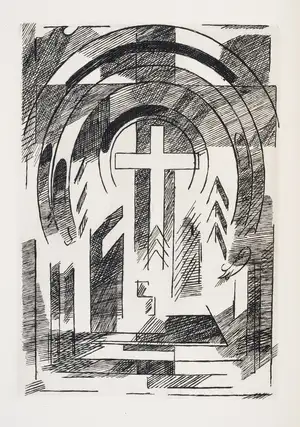Lot 214
Maurits Cornelis Escher (1898-1972)
Plane Filling I (Bool 373)
Hammer Price: £18,000
Description
Maurits Cornelis Escher (1898-1972)
Plane Filling I (Bool 373)
Mezzotint, 1951, a fine richly inked impression, signed and inscribed 'eigen druck' in pencil, numbered from the edition of 50, printed by the artist, on laid paper, with full margins, sheet 230 x 294mm (9 1/8 x 11 1/2in)
Provenance: Acquired directly from the artist;
thence by descent.
Lot Essay:
Escher sought to make the impossible fit within four corners of a flat sheet of paper. Visiting the Alhambra Palace in October 1922 as a young artist, Escher described his awe at the interlocking patterns of tiles and spent days sketching these mesmerizing tessellations. His work used what he termed ‘intuitive tessellation’ to defy perspective and entirely fill a space by ‘Plane Filling’.
Escher explains this concept in more detail writing, ‘A plane, which should be considered limitless on all sides, can be filled with or divided into similar geometric figures that border each other on all sides without leaving any ‘empty spaces’. This can be carried on to infinity according to a limited number of systems. I.e., a floor can be filled with tiles the same size. There are multiple ways to divide the plane from parallel lines intersecting at right angles to use of squares, diagonals, diamonds, and so on.’
In this particular work, we witness the interplay of metamorphic creatures ranging from butterflies, tortoises, bats, to other fantastical beings. Each climbing over and moving past each other to create an incredible sense of depth and movement, proving that it is possible to draw into every bit of space. The exact same form does not appear anywhere more than once.
In relation to his work, Escher referenced Bach’s music and its beating heart. He wrote of its relation to plane filling: ‘Just as music has different types of rhythmic organization, indicated by two, three, four and six beats to the bar, the division of a plane can be composed using two-, three-, four-, and sixfold rotation points, each representing a particular method of rhythmic repetition of the motifs in the plane.’
Description
Maurits Cornelis Escher (1898-1972)
Plane Filling I (Bool 373)
Mezzotint, 1951, a fine richly inked impression, signed and inscribed 'eigen druck' in pencil, numbered from the edition of 50, printed by the artist, on laid paper, with full margins, sheet 230 x 294mm (9 1/8 x 11 1/2in)
Provenance: Acquired directly from the artist;
thence by descent.
Lot Essay:
Escher sought to make the impossible fit within four corners of a flat sheet of paper. Visiting the Alhambra Palace in October 1922 as a young artist, Escher described his awe at the interlocking patterns of tiles and spent days sketching these mesmerizing tessellations. His work used what he termed ‘intuitive tessellation’ to defy perspective and entirely fill a space by ‘Plane Filling’.
Escher explains this concept in more detail writing, ‘A plane, which should be considered limitless on all sides, can be filled with or divided into similar geometric figures that border each other on all sides without leaving any ‘empty spaces’. This can be carried on to infinity according to a limited number of systems. I.e., a floor can be filled with tiles the same size. There are multiple ways to divide the plane from parallel lines intersecting at right angles to use of squares, diagonals, diamonds, and so on.’
In this particular work, we witness the interplay of metamorphic creatures ranging from butterflies, tortoises, bats, to other fantastical beings. Each climbing over and moving past each other to create an incredible sense of depth and movement, proving that it is possible to draw into every bit of space. The exact same form does not appear anywhere more than once.
In relation to his work, Escher referenced Bach’s music and its beating heart. He wrote of its relation to plane filling: ‘Just as music has different types of rhythmic organization, indicated by two, three, four and six beats to the bar, the division of a plane can be composed using two-, three-, four-, and sixfold rotation points, each representing a particular method of rhythmic repetition of the motifs in the plane.’







